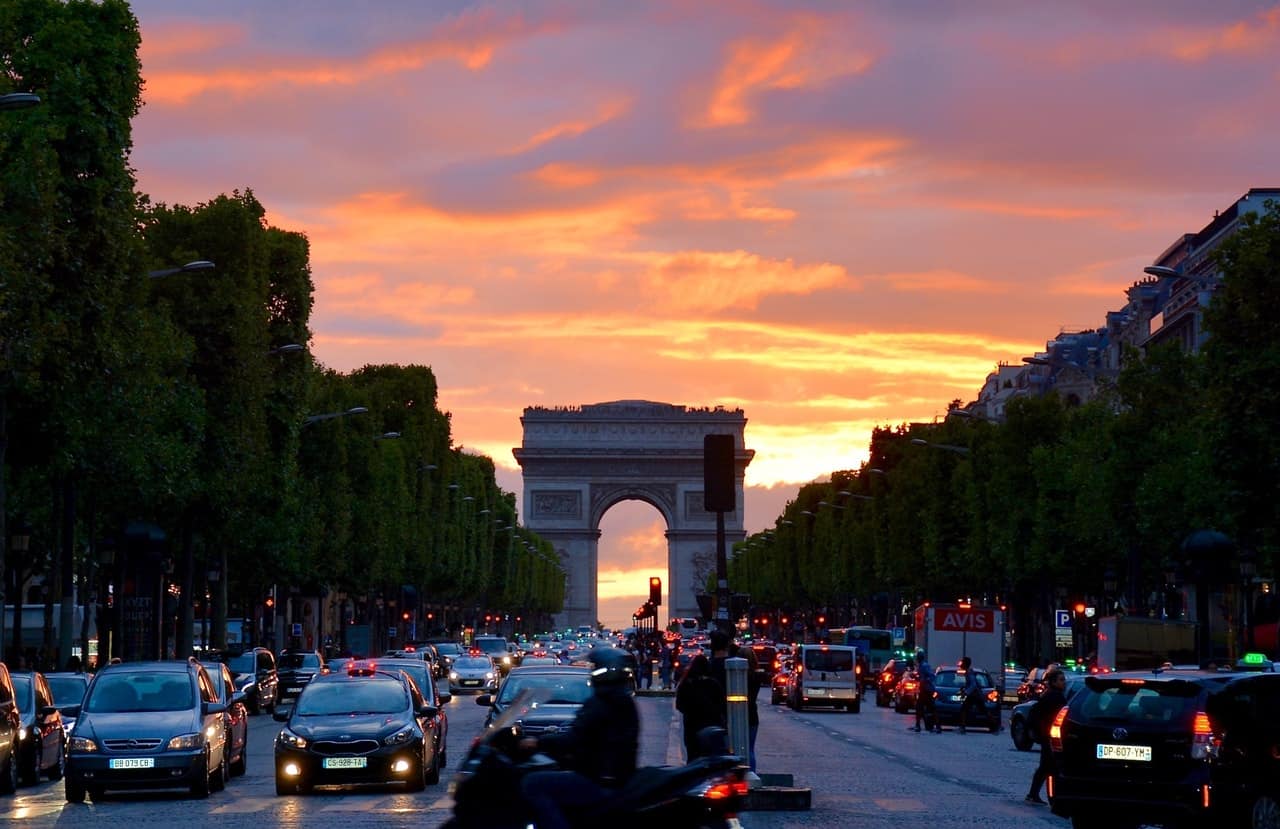L’Arc de Triomphe | Paris, France

Updated On: April 22, 2024 by Ahmed Samir
When one thinks of Paris, an image that invariably comes to mind is the majestic L’Arc de Triomphe. This iconic monument stands at the western end of the Champs-Élysées, symbolising France’s rich history and enduring spirit. With its stunning architecture, intricate sculptures, and profound historical significance, L’Arc de Triomphe is not just a tourist attraction but a testament to the nation’s triumphs and tribulations.
In this article, we will explore the history, architecture, symbolism, and cultural importance of L’Arc de Triomphe in Paris, France, delving into its captivating details and its profound impact on the cityscape and the collective consciousness of the French people.
Origins and Construction
L’Arc de Triomphe, also known as the Arc de Triomphe de l’Étoile, was commissioned by Napoleon Bonaparte in 1805 after his victory at Austerlitz, one of his most significant military triumphs. The primary purpose of the arch was to honour the French army and commemorate their victories, especially the Battle of Austerlitz. However, construction was not initiated until 1806 and was interrupted by various events, including Napoleon’s exile, before being completed in 1836 during the reign of King Louis-Philippe.
Designed by the architect Jean Chalgrin, L’Arc de Triomphe combines elements of Neoclassical and Empire styles with clear inspiration from ancient Roman architecture, notably the Arch of Titus in Rome. Its colossal structure is a testament to the grandeur and ambition of the French Empire during the 19th century.
Symbolism and Cultural Impact
L’Arc de Triomphe is not merely an architectural marvel but a potent symbol of France’s history, resilience, and national pride. It represents a profound statement of triumph over adversity, commemorating the French army’s victories and celebrating the nation’s enduring spirit.
- Commemorating Victory: The arch was initially intended to honour the victories of the French army during the Napoleonic Wars. Each of the sculpted reliefs and inscribed names on the arch’s façade is a testament to these achievements. It also pays tribute to the soldiers who fought and sacrificed for their country.
- National Unity: L’Arc de Triomphe symbolises French unity and resilience. Its central location, where twelve major avenues converge, reinforces the idea of France as a main force in the world and a united nation.
- Historic Gatherings: The arch has been a focal point for significant French history events. It witnessed the triumphant return of Napoleon’s remains in 1840, as well as numerous military parades, including the famous parade celebrating the liberation of Paris from Nazi occupation in 1944.
- Cultural Inspiration: L’Arc de Triomphe has been a source of inspiration for artists, writers, and filmmakers. It has appeared in countless works of literature, painting, and cinema, making it an enduring symbol of Paris and France in global culture.
- National Mourning: The arch is a mourning symbol during a national tragedy. Following the 2015 terrorist attacks in Paris, the arch was illuminated with the colours of the French flag, serving as a beacon of hope and resilience during a dark period.
Visiting L’Arc de Triomphe:
Visiting L’Arc de Triomphe is a must for anyone travelling to Paris. The monument is open to the public year-round, with different hours of operation depending on the season. Tickets can be purchased on-site or in advance, and discounts are available for students, children, and disabled visitors.
Once inside, visitors can explore the museum within the arch, which provides historical context and fascinating exhibits related to the monument’s construction and significance. Afterwards, taking the spiral staircase or elevator to the rooftop terrace is highly recommended for the unparalleled views of Paris.
Tips for a Memorable Visit:
- Arrive Early: To avoid crowds, arrive at L’Arc de Triomphe early in the morning or later in the evening, especially during peak tourist seasons.
- Sunset Spectacle: Watching the sunset from the rooftop terrace offers a truly magical experience as the city’s landmarks illuminate against the evening sky.
- Learn About the History: Take your time to read the inscriptions and explore the museum’s exhibits to gain a deeper appreciation of the arch’s historical significance.
- Dress Comfortably: Wear comfortable shoes and clothing suitable for climbing stairs and walking on the rooftop.
- Photography: Remember your camera! The views from the top of the arch are a photographer’s dream.
Exploring the Enchanting Neighbourhood
L’Arc de Triomphe is situated in a vibrant area of Paris that offers numerous attractions and points of interest. Here are some notable attractions and places to explore near L’Arc de Triomphe:
- Champs-Élysées: The famous Avenue des Champs-Élysées stretches from L’Arc de Triomphe and is known for its high-end shops, theatres, and cafes. Stroll along this iconic boulevard, shop at designer boutiques, and enjoy the lively atmosphere.
- Place de la Concorde: Located at the other end of the Champs-Élysées, Place de la Concorde is one of the largest public squares in Paris. It features a striking Egyptian obelisk and beautiful fountains. The square is rich in history and is where King Louis XVI and Marie Antoinette were executed during the French Revolution.
- Palais de l’Élysée: The official residence of the President of the French Republic, the Palais de l’Élysée, is also nearby. While the palace isn’t typically open to the public, you can admire its grand architecture and take a leisurely walk in the adjacent Elysée Gardens.
- Grand Palais and Petit Palais: These neighbouring exhibition halls, known as the Grand Palais and Petit Palais, host various cultural events, art exhibitions, and collections. The Grand Palais is particularly famous for its stunning glass roof.
- Parc Monceau: A picturesque park located a short distance from L’Arc de Triomphe, Parc Monceau offers a serene escape from the bustling city. It features charming walking paths, statues, and a collection of follies, including a Corinthian colonnade.
- Musée Jacquemart-André: Situated in a beautiful mansion, this museum houses an impressive art collection and decorative objects. You can explore works by renowned artists like Rembrandt, Botticelli, and Fragonard while enjoying the opulent interiors.
- Eiffel Tower: While not exactly next door, the iconic one is easily accessible from L’Arc de Triomphe by a pleasant walk along the Seine River. Visiting the Eiffel Tower is a must-do in Paris, offering breathtaking city views from observation decks.
- Musée Nissim de Camondo: Located near Parc Monceau, this museum is in a beautiful mansion and showcases the stunning collection of decorative arts amassed by the Camondo family. It provides a glimpse into the opulent lifestyle of the Belle Époque era.
- Parc des Batignolles: Another nearby park, Parc des Batignolles, offers green spaces, a picturesque pond, and walking trails. It’s a lovely spot for a leisurely afternoon stroll or a picnic.
- Montmartre: A bit farther but still within reach, Montmartre is known for its stunning Sacré-Cœur Basilica and artistic heritage. Climb the hill to explore the charming streets and cafes and enjoy panoramic city views.
These attractions near L’Arc de Triomphe offer diverse experiences, from shopping and cultural enrichment to peaceful moments in lush green spaces. Whether you’re interested in history or art or simply enjoying the beauty of Paris, there’s something for everyone in this vibrant city area.
Conclusion:
L’Arc de Triomphe is a living testament to France’s history, culture, and enduring spirit. As an architectural masterpiece, it symbolises triumph over adversity, commemorating the nation’s victories and honouring those who served. Its central location and breathtaking views make it a must-visit destination for anyone exploring the enchanting city of Paris.
So, whether you’re drawn to its stunning architecture, fascinated by its historical significance, or simply captivated by the panoramic views, L’Arc de Triomphe is a timeless symbol of French glory that continues to inspire and awe visitors worldwide. It is a reminder that even in the face of challenges, the spirit of France perseveres, standing tall and proud for all to see.
FAQs
Are there any recommended times to visit these attractions to avoid crowds?
Early and late afternoons are generally less crowded to visit many of these attractions. Weekdays are also typically quieter compared to weekends.
What is the best way to reach L’Arc de Triomphe and the surrounding attractions?
L’Arc de Triomphe is easily accessible by the Paris Metro. The nearest station is Charles de Gaulle-Étoile (Lines 1, 2, and 6), just a short walk from the arch. Additionally, buses and taxis are readily available in the area.
Are audio guides or guided tours available in languages other than French?
Several attractions offer audio guides and guided tours in multiple languages, including English, Spanish, German, and more. Check with the attraction’s official website or on-site information for language options.
Are there any special events or exhibitions currently taking place at these attractions?
The events and exhibitions at these attractions can vary throughout the year. To stay updated on current events, special exhibitions, and temporary displays, visit the official websites of each attraction or inquire on-site.
Is there a recommended order to visit these attractions for an efficient and enjoyable experience?
The order in which you visit these attractions can depend on your interests and priorities. However, starting with L’Arc de Triomphe and exploring nearby attractions such as the Champs-Élysées and Place de la Concorde is a common and efficient route.






